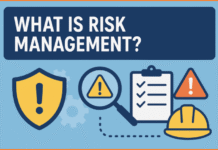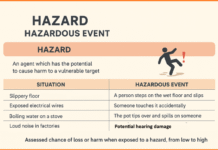Contents
Introduction to Proactive Safety Measures
The concept of proactive safety measures in the workplace represents a fundamental shift in how organizations approach the well-being of their employees. As elucidated by Dan Petersen in 2003, proactive safety measures are designed to anticipate and prevent accidents before they occur, rather than merely reacting to incidents after they happen. This forward-thinking strategy is essential for fostering a safe and productive work environment.
Proactive safety measures differ significantly from reactive measures, which typically focus on responding to injuries or accidents after the fact. While reactive measures are crucial for managing immediate consequences and preventing recurrence, proactive approaches aim to eliminate hazards and risks at their source. By identifying potential dangers early and implementing preventive strategies, organizations can mitigate the likelihood of accidents and minimize their impact.
Line supervisors play a pivotal role in the successful implementation and maintenance of proactive safety measures. Their position allows them to directly influence the day-to-day operations and behaviors of their teams. Supervisors are accountable for ensuring that safety protocols are adhered to and for fostering a culture of safety awareness among employees. This involves regular safety training, conducting risk assessments, and promoting open communication about potential hazards.
By embracing proactive safety measures, line supervisors can take a more active role in safeguarding their workforce. This not only enhances the overall safety of the workplace but also demonstrates a commitment to the well-being of employees, which can lead to increased morale and productivity. Through vigilant supervision and continuous improvement of safety practices, supervisors can help create an environment where risks are minimized, and employees can perform their duties with confidence and security.
The Role of Line Supervisors in Safety Management
Line supervisors play a critical role in safety management within any organization. Their responsibilities extend beyond merely overseeing daily operations to actively integrating proactive safety measures into their routines. This integration involves a vigilant approach to identifying and mitigating potential hazards before they escalate into serious issues. By fostering a culture of safety, supervisors ensure that their teams operate in a secure environment, minimizing the risk of accidents and injuries.
One of the primary responsibilities of line supervisors is to conduct regular safety inspections and audits. These inspections allow supervisors to identify unsafe conditions and behaviors, providing an opportunity to address them promptly. By maintaining a constant awareness of the work environment, supervisors can proactively implement corrective actions and preventive measures. This vigilant approach is crucial in mitigating risks and ensuring the safety of all team members.
Another key aspect of a supervisor’s role in safety management is effective communication. Supervisors must clearly convey safety policies and procedures to their teams, ensuring that everyone understands and adheres to them. Regular safety meetings and training sessions are essential for keeping team members informed about potential hazards and the measures taken to address them. By fostering open communication, supervisors encourage team members to report unsafe conditions and suggest improvements, thereby enhancing overall safety.
Moreover, line supervisors need a solid foundation of safety knowledge and skills. This includes understanding regulatory requirements, hazard identification techniques, and emergency response protocols. Continuous learning and professional development are vital for supervisors to stay updated on the latest safety practices and technologies. Equipped with this knowledge, supervisors can effectively guide their teams in maintaining a safe work environment and promptly responding to any incidents that may arise.
In summary, the role of line supervisors in safety management is multifaceted and essential to the well-being of an organization. By integrating proactive safety measures, maintaining vigilance, and fostering a culture of open communication, supervisors safeguard their teams and contribute to a safer work environment. Their expertise and proactive approach are key to preventing accidents and ensuring the overall safety of the workplace.
Key Activity Measures for Line Supervisors
Effective safety management within the workplace begins with proactive measures executed by line supervisors. Dan Petersen (2003) underlines several critical activities that supervisors should undertake to ensure a safe working environment. One fundamental measure is conducting regular safety audits. These audits involve a thorough review of the workplace to identify potential hazards, ensuring that all safety protocols are followed, and rectifying any deviations promptly. Regular audits help maintain high safety standards and foster a culture of continuous improvement.
Another crucial activity is the implementation of comprehensive employee training programs. These programs should encompass a variety of safety topics, including proper equipment usage, emergency response procedures, and hazard recognition techniques. By equipping employees with the necessary knowledge and skills, supervisors can significantly reduce the likelihood of accidents and injuries. Training sessions should be conducted regularly to reinforce safety practices and update employees on new safety regulations or equipment.
Hazard identification is another core responsibility of line supervisors. This involves not only recognizing existing hazards but also anticipating potential risks that could arise from changes in operations or the introduction of new equipment. Supervisors should encourage employees to report any hazards they observe and actively participate in hazard identification processes. This collaborative approach ensures that potential dangers are addressed promptly, minimizing the risk of workplace incidents.
Emergency preparedness is also a key activity measure. Line supervisors must develop and maintain robust emergency plans that outline clear procedures for various scenarios, such as fires, chemical spills, or natural disasters. These plans should be regularly reviewed and updated, with drills conducted to ensure all employees are familiar with emergency protocols. Effective emergency preparedness can significantly mitigate the impact of unforeseen events, protecting both employees and the organization.
By focusing on these proactive measures—regular safety audits, thorough employee training, diligent hazard identification, and comprehensive emergency preparedness—line supervisors can create a safer work environment. These activities not only help prevent accidents but also contribute to a culture of safety that prioritizes the well-being of all employees.
Benefits and Challenges of Implementing Proactive Safety Measures
Implementing proactive safety measures in the workplace offers numerous benefits that can significantly enhance the overall safety culture. One of the foremost advantages is the reduction in workplace incidents. By identifying and mitigating potential hazards before they result in accidents, line supervisors can create a safer working environment. This preemptive approach not only minimizes the risk of injuries but also reduces the associated costs of workplace incidents, such as medical expenses and downtime.
Another significant benefit is the improvement in employee morale. When employees see that their safety is a priority, it fosters a sense of trust and commitment towards the organization. This trust can lead to increased job satisfaction and productivity, as employees feel more secure and valued in their roles. Moreover, a strong safety culture, reinforced by proactive measures, sets a positive example for all employees, encouraging them to take personal responsibility for their safety and that of their colleagues.
However, the implementation of proactive safety measures is not without its challenges. One of the primary obstacles is resistance to change. Employees and even some supervisors may be reluctant to alter established routines and practices. Overcoming this resistance requires effective communication and involvement of all stakeholders in the safety planning process. Educating employees on the benefits of these measures and providing training can help alleviate apprehensions.
Resource allocation is another potential challenge. Proactive safety initiatives may require investment in new equipment, training programs, or additional personnel. Organizations must carefully evaluate their budgets and prioritize safety expenditures without compromising other operational areas. Leveraging cost-effective measures, such as regular safety audits and employee-led safety committees, can help balance resources effectively.
Finally, the need for continuous improvement cannot be overstated. Safety is an ongoing process, and proactive measures must evolve with changing workplace dynamics and emerging risks. Establishing a culture of continuous improvement involves regular review and updating of safety protocols, fostering open communication, and encouraging feedback from employees to identify areas for enhancement.
By recognizing the benefits and addressing the challenges of proactive safety measures, line supervisors can play a pivotal role in cultivating a safer and more productive workplace. Practical strategies, such as engaging employees in the safety process, allocating resources judiciously, and fostering a culture of continuous improvement, are essential for the successful implementation of these measures.





